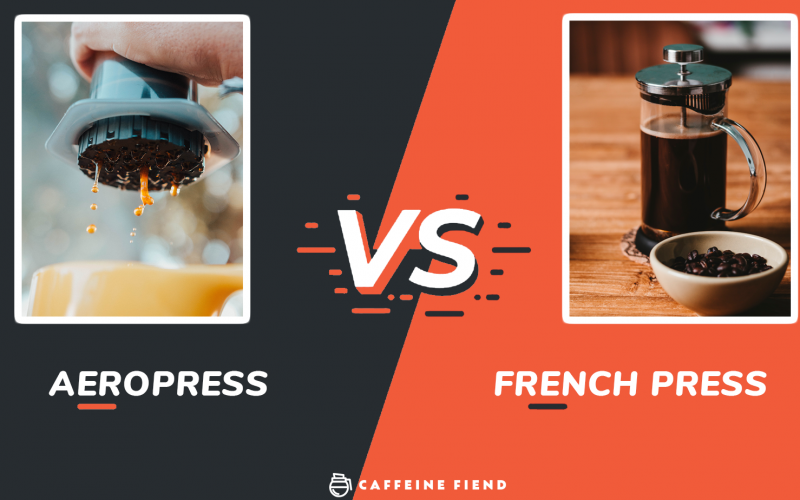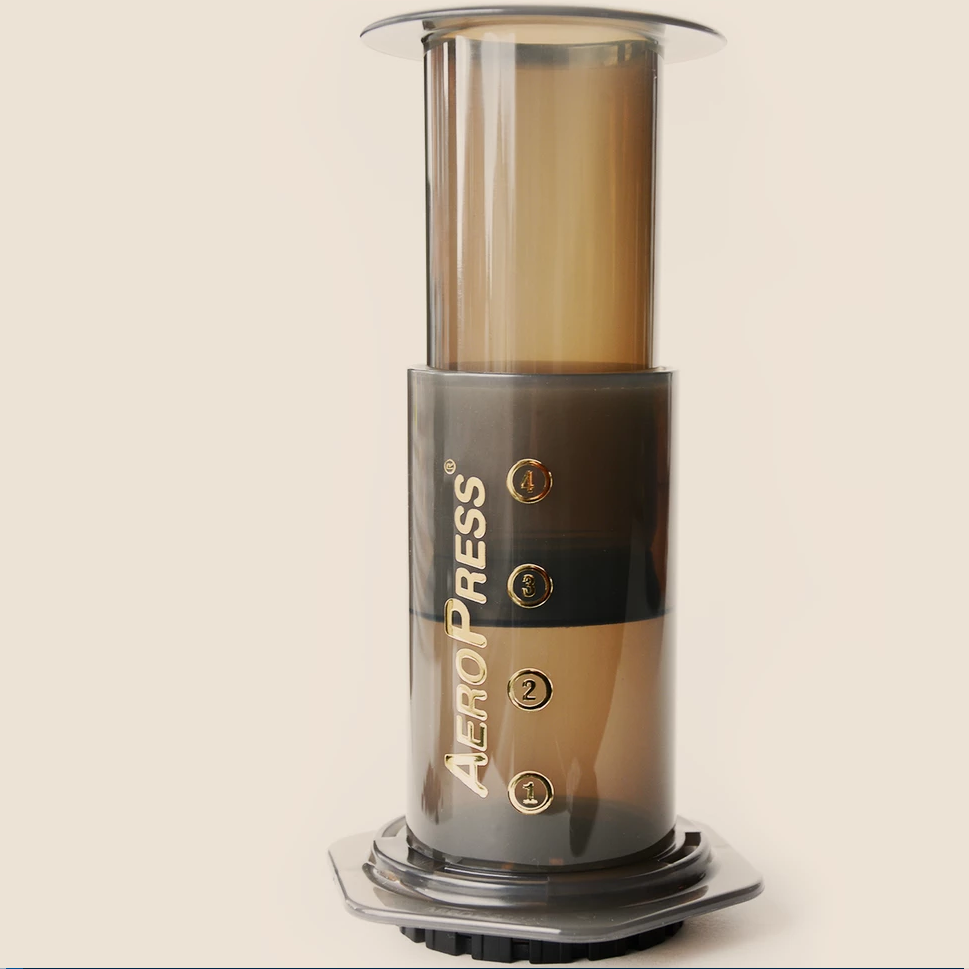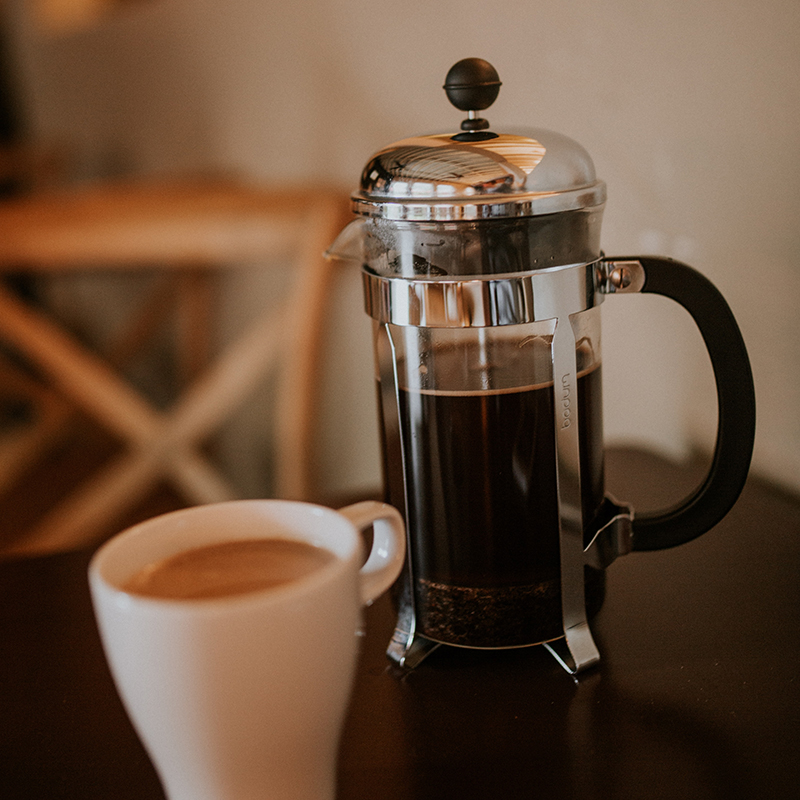Espresso, macchiato, cappuccino, AeroPress and French press – these are just some of the more popular styles of coffee on offer when visiting your average coffee shop. They’re designed to appeal to a broad range of tastes, and this often leads to a lot of amicable disagreement about which style is the best.
The answer, as you might imagine, isn’t so straightforward and requires quite a bit of unpacking.
While it does depend in part on your taste and preferred style, many coffee experts across the board all agree on one thing: when it comes to brewing coffee at home, it’s hard to beat press style coffee. And at the forefront of the press movement are the two firm favorites: the French press and the Aeropress.
But what sets these apart from other brewing methods, and what makes them so superior? At first glance it might not even seem obvious, especially since both contraptions look quite similar in style and produce a similarly high quality cup of coffee. The details are in the process, however, and it’s this that has placed them firmly in the good graces of coffee afficandios across the world.
The secret? Hot water and pressure – and lots of it. Utilizing these two factors in both the Aeropress and the French press provides the means to expertly manipulate and extract delicate flavors where other methods fall short.
What do French Press and AeroPress have in common?
As we mentioned briefly above, to the layman who doesn’t know too much about coffee production, the AeroPress and French press might look similarly strange. Both feature a plunger mechanism and a large chamber for storing liquid, and they also rely on the same mechanism for actually brewing the coffee – steadily applied pressure.
The AeroPress – Image from the Official UK AeroPress website The French Press
Unlike other methods which rely on complicated coffee machinery, these two tools are remarkably simple. Both use very few moving parts and rely on first steeping the coffee grinds before filtering them out and extracting the final product. It’s this steeping technique – all called immersion – that is unique from other coffee production methods.
The process of steeping coffee grounds allows for a lot of control over brewing variables which ultimately affect the final flavor. These variables include the steeping time, the temperature of the water, the amount of coffee grinds used and the volume of hot water added.
But for all their similarities, they’re still very distinct pieces of equipment.
AeroPress vs French Press – The Big Difference:
Mechanically, the major differences between the French press and the AeroPress have to do with the way in which the coffee grinds are filtered. While both methods rely on steeping the coffee grinds in order to extract the flavor, the filters they employ to the job are quite different.
The AeroPress relies on a very fine, disposable paper filter in order to filter out the coffee grinds, while the French press utilizes a much more coarse steel filter which is attached to the plunger. The AeroPress also uses air pressure in order to force water through the filter and separate the grinds, while with the French Press the grinds are separated by being forced to the bottom of the chamber.
The use of a paper filter in the AeroPress means that a lot of the essential oils and aromatic essences of the coffee are going to be filtered out, while the coarser filter used in the French press allows them through. The trade-off for losing some of this intensity is that an AeroPress is going to deliver a much more balanced and consistent cup of coffee.
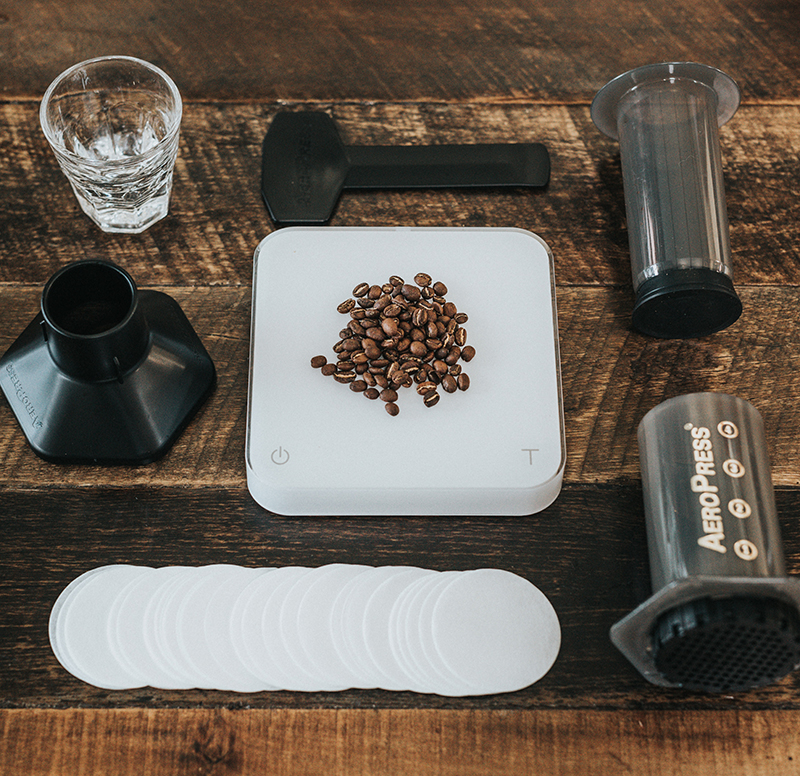
That being said, if you want don’t want to settle for your standard AeroPress kit, you can always invest in a set of reusable stainless steel filters of varying finenesses to take it to the next level. This will give you greater control of your coffee’s flavor, acidity and intensity.
AeroPress Coffee
What is it?
But for all of its hype and praise, what exactly is an AeroPress? Invented in 2005 by Alan Adler, the AeroPress is probably the youngest and one of the most recent coffee inventions to change the coffee industry entirely.
Its build consists of two cylinders made from high quality plastic. The smaller cylinder has a flexible airtight seal and rests inside the larger cylinder, similar to that of a syringe. The larger cylinder has space for either a disposable paper filter, or reusable steel filters, which the coffee grinds and hot water are then placed on top of.
The AeroPress is famous for using pressure in order to extract flavor from coffee beans and produce an espresso-style drink. While it will never be able to match the 9 bars of pressure produced by an espresso machine, the pressure it can produce by hand is quite impressive. Keen baristas can also invest in filters such as those by Fellow Prismo in order to achieve even greater levels of pressure for a more fully-extracted final product.
Unlike the French press, which has been around for quite some time and exists in many different variations, the AeroPress is unique in that it is not only a device, but a brand name, too. This means that there is only one variation of this particular device which is used across the coffee industry.
AeroPress’ hidden Superpowers
From the outside looking in, it may seem as though you need a plethora of intricate equipment in order to produce coffee even marginally better than a mug of freeze-dried instant. The AeroPress, with its simple design and affordable price tag, dispels those myths instantly upon use.
These aren’t the AeroPress’ only positive attributes, however. In fact, the device is so popular among coffee fans because of everything else it delivers.
To start with, the AeroPress is extremely durable and light. This makes it the ideal travel companion, and perfect for someone who is always on the go but wants to enjoy a proper cup of coffee in their hotel room or AirBnb.
It’s also extremely affordable compared to other brewing methods of comparable quality. An AeroPress starter kit with a year’s worth of filters will only set you back about $30 depending on where you buy it from.
Brewing coffee in an AeroPress results in a much smoother brew over other conventional brewing methods. This has to do with the fact that grinds are being steeped in hot water before being filtered, and that nothing is left out during the extraction process. This also results in a much shorter brewing time than something like drip coffee.
The shorter brewing time is also a key factor in the final taste of the coffee, which by and large is much less acidic than even French press brew. All of these factors result in a smooth, easy to drink and consistently great cup of coffee.
How to make AeroPress Coffee
So after reading the above guide, we assume by this point you’re hooked. You’ve got your AeroPress and now you’re wondering exactly how to use this contraption and create the wonderful coffee we’ve waxed lyrical about. It’s pretty simple:
- Boil some water, let it rest then set it aside while you prepare the other components of your coffee.
- Grind your beans. The AeroPress usually requires a finer grind that even espresso, so make sure you have a grinder that can handle this. You want to use about four tablespoons of coffee grinds.
- Assemble the AeroPress by placing your filter in the bottom of the larger cylinder, then placing it on top of a mug or other container. Splash a little hot water onto the filter before you start to avoid having the papery taste of it affect the coffee.
- Add the coffee grinds. If you’re unsure about your aim use the funnel provided.
- Once your water has rested add it into the coffee grinds until it’s near the top line.
- Stir the mixture briefly and then allow it to steep for 20 – 30 seconds.
- Insert the plunger on top of the AeroPress. Apply steady pressure to the plunger until you begin to hear a long hiss and the coffee accumulates in the mug below.
- Enjoy your creation. The AeroPress is known for quite strong espresso-style coffee, so if you find that it’s a little bit too intense try splitting it between two or more cups.
An Alternative Way to Make AeroPress Coffee
Introduced in 2005, the AeroPress is definitely one of, if not the, youngest brewing methods to hit the coffee market. Bluntly put, it took the world by storm, and baristas have been figuring out creative ways of using this device other than its intended purpose ever since. And while numerous methods have made the cut, perhaps the most popular is the Upside-Down AeroPress Brewing Technique.
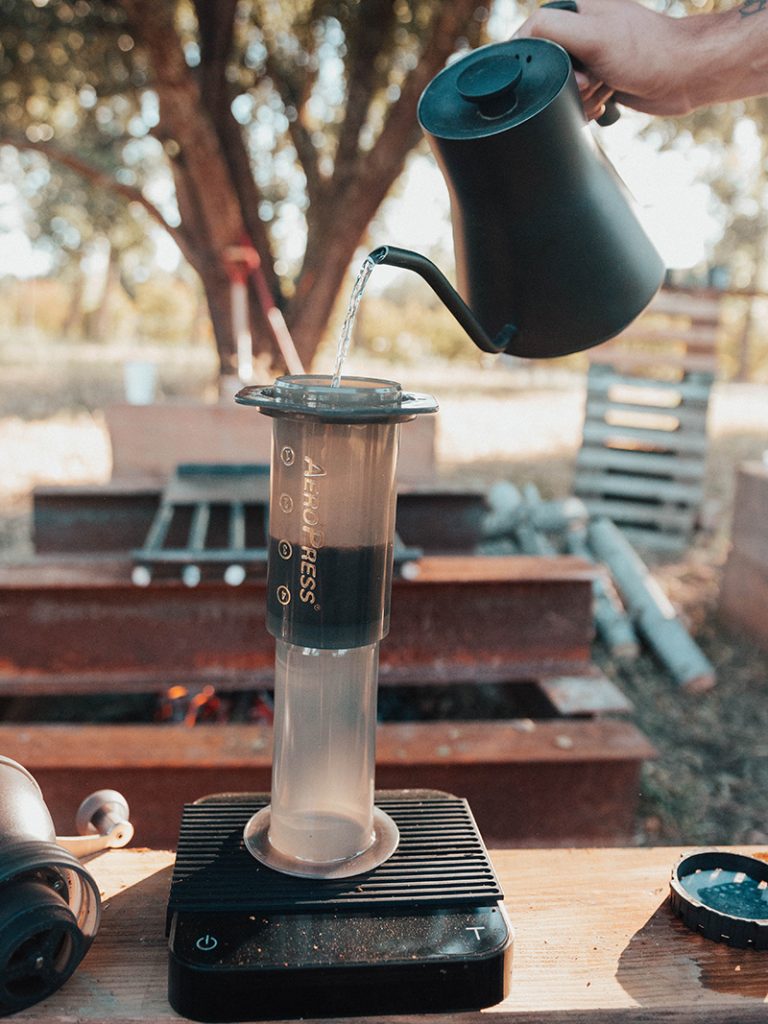
To make it you’re going to need all of the same ingredients used to make normal AeroPress coffee. The main difference is the setup of the AeroPress itself.
You’ll want to start by placing the plunger on the counter facing upwards. Then, turn the brewing chamber upside down and place it securely on the plunger, resting the stopper around the #4 marking on the chamber. Now add your coffee and hot water just as you normally would.
Secure the filter to the top of the AeroPress and let the coffee brew for around 90 seconds. Unlike a normal AeroPress setup, this method allows the coffee to become fully immersed in a process actually quite similar to the French press.
When you’re ready, flip the AeroPress and place it on your mug or desired container. Apply pressure as you normally would and in 20 seconds or so your Upside Down AeroPress coffee is ready to go.
Since making coffee this way can occasionally get a little bit messy, it helps to have something like the AeroPress organizer just to ensure all of your AeroPress parts are properly stored and ordered.
French Press
What is it?
Now that we’ve spoken at length about the AeroPress, it’s time to address the other device in the room.
The French press is a staple piece of kit for anyone looking to make premium, delicious coffee at home. It consists of a glass cylinder and a plunger with a fine wire mesh attached to it. Some variations of the French press are also made from steel or ceramic.
We went into detail about the history of the French press in a previous article, but some pertinent facts are worth repeating. Patented by Milanese designer Attilio Calimani in 1929, the French press is actually an Italian design, although it may have been first created in France.
It saw a rise of popularity across Europe in the 60s and eventually became a common household device for making coffee. Its ability to make copious and consistently delicious cups of coffee, as well as draw out the best quality of the coffee being used, also makes it a firm favorite among baristas.
The Myriad Advantages of using a French Press
To start with, the French Press is a very simple device. Consisting of only two separate parts, it makes producing a surprisingly good cup of coffee a very easy affair.
Unlike other methods of producing coffee – looking at you, espresso – the French press is also able to produce relatively large amounts of coffee per brew. Whereas the AeroPress, for example, will only produce enough coffee for one or two people, the French press makes enough for six. This means you don’t have to brew multiple times when having guests over.
The French press is also renowned for allowing maximum control when it comes to manipulating the flavor profile of the coffee. From the amount of coffee used, the water temperature and volume, and steeping time of the coffee, the French press lets you fully determine how long you would like to extract the coffee for.
And because the grinds are steeped before it is filtered, the French press retains many of the oils and aromas that other methods lose. The resultant brew is more textured, intense and contains a more complex flavor profile that other filtered coffee.
How To Make a Perfect Cup of French Press Coffee
Making the perfect cup of French press isn’t rocket science. In fact, it couldn’t be simpler.
- Grind up the bean of your choice – about 8 grams of coffee to 200ml of water. The type of bean and roast you choose are the main determinants when it comes to your coffee flavor. The grinder you use, and the way you grind it, also play a role, so ensure you pick the correct fineness.
- Add the ground up coffee to the cylinder.
- Boil some water. Let it rest for about 30 seconds and add it to the cylinder.
- Stir the mixture gently with a spoon or coffee stirrer.
- Place the plunger on top of the cylinder but don’t push it just yet. Allow the French press to sit like this for around 3 to 4 minutes. If you like your coffee extra strong, let it steep for longer.
- Once it has rested, push the plunger down slowly, applying steady, even pressure.
- Enjoy! Some sediment may find its way into the final brew. This is normal and shouldn’t affect the final flavor.
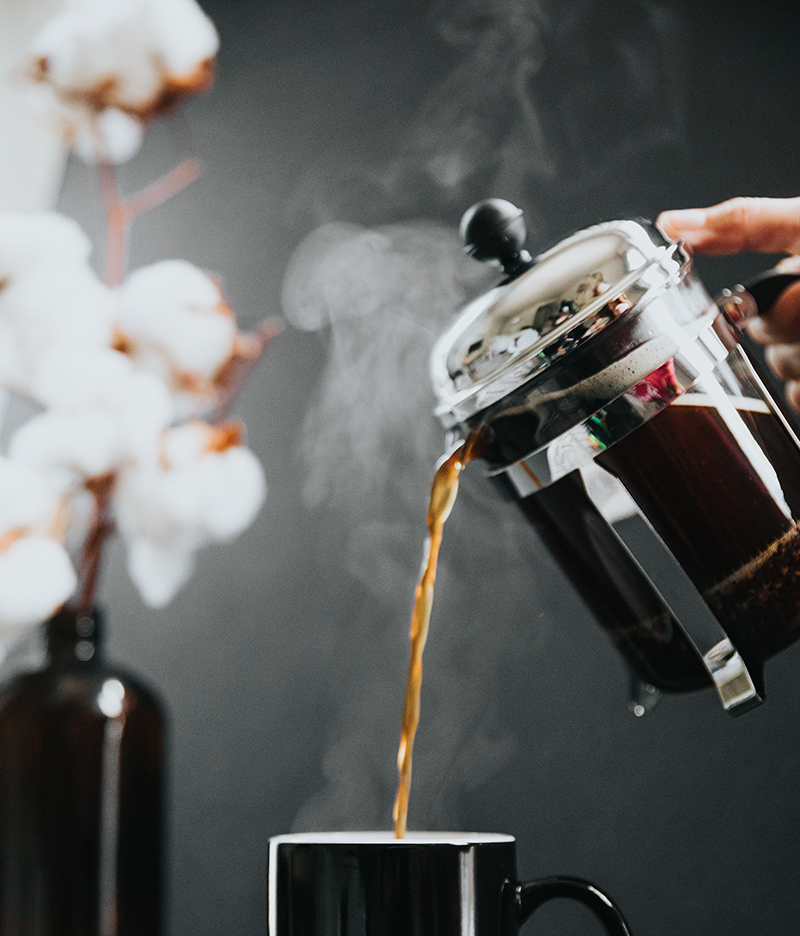
AeroPress vs French Press – Which is Best?
The showdown between the AeroPress and French press is one of the most heated in the coffee world. While both devices require manual use, and utilize steeping as the brewing technique – admittedly very similar functionalities – the distinct difference between them lies in the way in which the coffee is filtered.
And because so many coffee aficionados want to have ultimate control of the exact flavor of their coffee, this is oftentimes the deciding factor on which device they opt to buy.
While both brewing methods offer control over most of the crucial variables that determine coffee flavor, each method possesses a quality that sets it apart from the other.
With the AeroPress, it’s pressure. While you won’t achieve anything close to the massive amounts of pressure generated by an espresso machine, you can produce a not insignificant amount of force with this trusty little hand brewer. It’s this pressure which allows for a faster and (some would say) more complete extraction.
The French press, on the other hand, allows for more complex flavors and aromas. Because the filter used is a more coarse and made of steel, many of the oils found within the coffee are retained. The resultant brew is generally tastier, more intense and more aromatic.
So if you’re after a cup of coffee with a stronger flavor profile, then the French press is your friend. If, however, you prefer a more rounded cup of coffee, then you can’t go wrong with the AeroPress.

